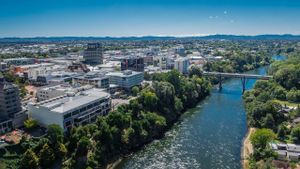Residents of northern states across the U.S. have been treated to extraordinary displays of the northern lights during Thanksgiving week, thanks to geomagnetic storms caused by heightened solar activity. Just as families were gathering to give thanks, the skies above offered vibrant streaks of green, pink, and purple, captivating those lucky enough to be under clear, dark skies.
According to forecasts from the National Oceanic and Atmospheric Administration (NOAA), the Kp index—a measure of geomagnetic activity—was set to rise dramatically over the holiday period. On Thanksgiving night, with the Kp index reaching significant levels, the auroras were expected to reach much farther south than usual, illuminating the night sky from states like Montana, North Dakota, and Minnesota.
NOAA confidently stated the chances of observing these celestial wonders were quite promising. A Kp index of three on the evenings leading up to Thanksgiving and even higher levels forecasted for the holiday itself suggested optimal conditions for lower latitudes to witness this breathtaking spectacle. Reports indicated Kp values hitting five and potentially nearing six, creating vibrant auroras visible to people who rarely get the chance to see such phenomena.
The mechanics behind the lights involve the interaction between charged solar particles from the sun and Earth's magnetic field. When these particles collide with gases in the atmosphere, they excite different atoms, causing them to emit light. This is why colors change, producing the stunning visual displays we associate with the phenomenon.
People hoping to catch the northern lights were advised to find dark locations away from city lights; the best viewing times were said to be between 10 p.m. and 2 a.m. local time. Those living near the Canadian border or any sparse areas were urged to embrace the opportunity, with many grabbing their cameras for what could be the last chance to see this natural wonder for some time.
The excitement was immense, especially considering solar activity is currently hitting its peak phase—known as solar maximum. This heightened activity is part of the sun's 11-year solar cycles, and NASA predicts it will continue to affect auroral displays through 2025. Experts believe the solar maximum can lead to unexpected increases in visibility for auroras, giving people across the U.S. more opportunities to witness spectacular cosmic displays.
NASA issued forecasts indicating not just minor solar flares, but also significant coronal mass ejections, which are vast clouds of charged particles released during solar eruptions. A notable filament eruption recently observed on the sun's surface raised hopes for continued auroral visibility deep south through the holiday week.
While many observed the colors dancing across the horizon, they were encouraged to take photographs if they had the right equipment. For traditional camera users, setting with high ISO values and wide apertures provides the best chances to capture the light. Smartphone users were similarly advised to activate night mode to improve clarity and detail.
This holiday season's unique blending of Thanksgiving festivity with the natural beauty of the northern lights also sparked conversations about where and how to catch the best view. Significant areas reported sightings, including places like northeastern Oregon, northern Idaho, South Dakota, and even parts of upper Michigan, which typically have limited chances for observing auroras.
The excitement surrounding this year’s northern lights was palpable, with social media flooded with snapshots and stories. While some locations reported more prominent displays than others, the overall experience of witnessing the lights was described as one of awe and wonder, making it not just another holiday but one filled with unforgettable memories.
With the northern lights continuing to grace the skies across various states, many reflected on the extraordinary beauty of nature's displays amid family gatherings and holiday celebrations. Whether through the lens of their cameras or through the simple act of gazing up at the swirling colors, this Thanksgiving offered not just gratitude, but also a moment of magic as the heartwarming glow of the auroras lit up the night.



